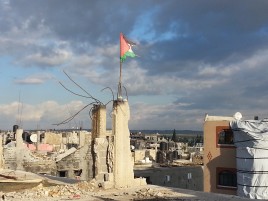
“Promoting dialogue and peace in the Holy Land” it is the theme of the annual pilgrimage of the bishops of the Holy Land Coordination (HLC) to Gaza, Ramallah and East Jerusalem from 11 to 16 January. HLC (Holy Land Coordination) brings together bishops from European and North American Episcopal Conferences, with delegates from CCEE and COMECE, national and international charity organizations and representatives of other Christian denominations.
 The purpose of the pilgrimage, which has been taking place for more than 20 years, is to show closeness and solidarity to the Christian communities of the Holy Land. The bishops, a group of fifteen this year, will visit Gaza, Ramallah and East Jerusalem. On the occasion of the pilgrimage SIR interviewed the Italian delegate to HLC 2020, Msgr. Rodolfo Cetoloni, Bishop of Grosseto, Friar Minor, with close ties to the Holy Land, where, among other things, he was ordained a priest.
The purpose of the pilgrimage, which has been taking place for more than 20 years, is to show closeness and solidarity to the Christian communities of the Holy Land. The bishops, a group of fifteen this year, will visit Gaza, Ramallah and East Jerusalem. On the occasion of the pilgrimage SIR interviewed the Italian delegate to HLC 2020, Msgr. Rodolfo Cetoloni, Bishop of Grosseto, Friar Minor, with close ties to the Holy Land, where, among other things, he was ordained a priest.
“Promoting dialogue and peace in the Holy Land” is the theme of this year’s visit. In view of the recent developments in the region, between Iran, Iraq, the USA, Syria, Lebanon, does talking about peace and dialogue risk becoming a mere exercise in style?
This year’s pilgrimage urges us to pay close attention to what is happening in neighbouring countries. Tensions are also felt in the Holy Land and as bishops of the HLC, we are called to foster greater hope even in small gestures at individual level. Without, however, lapsing into delusions.
I believe that never as today the focus should be on dialogue as the only way to achieve peace, even if the winds are blowing in the opposite direction.
In this regard, it is worth noting that this year’s programme is clearly directed towards meetings with young people and with educational and school realities in Gaza, Bethany, Ramallah and Jerusalem. It is the humble and strong path of education that must be pursued.
Why humble?
Because the other paths are trodden by the powerful. As Church and as a Christian community we have no other path than that of educating and forming people to tolerance and encounter. We do this also through our concrete presence and closeness.
Standing close to people also means offering signs of hope.
Helping young people to think differently in this world fraught with tensions and aggressiveness is a priority. We must defend the new generations from so much violence.
The Comboni sisters in Bethany, that you will be visiting on 14 January, are aware of this. The separation wall built by Israel has in fact divided their convent from the school they run, forcing pupils to travel several kilometres to attend classes. Israel has only allowed one gate to remain open for 10 minutes in the morning and 10 minutes in the afternoon. This situation has been dragging on for almost 10 years…
The Wall is a chronic reality. Hopefully it will fall like other walls have fallen. The situation in Bethany is dreadful, separating the children from their school, the attempt to open a gate – which also shows a certain sensitivity on the part of Israel to address these human situations – even if only for a few minutes, shows just how certain choices harm the daily life of ordinary people.
The pilgrimage will be an opportunity for reflection on the Israeli settlements that remain one of the most problematic issues to be resolved as part of a hoped-for resumption of negotiations…
It’s another hot issue. As with the Wall, also the settlements would require other figures involved and a genuine willingness to deal with the problem. If not, the hopes and intentions of those seeking solutions and new paths will be dashed.
Continually frustrating people’s hopes leads to anger, resentment and reactions ultimately exacerbating the present situation.
 The programme includes a stopover in the Gaza Strip, an open wound in the conflict between Israelis and Palestinians. The visit to the local Christian community is eagerly awaited…
The programme includes a stopover in the Gaza Strip, an open wound in the conflict between Israelis and Palestinians. The visit to the local Christian community is eagerly awaited…
The purpose of the visit is to show our closeness to this community. It’s but a small sign, but we owe it to our brethren living in the Strip, in spite of the headwinds that distance their hopes in an end to the conflict. It will be an opportunity to listen and understand just how our brothers in the Holy Land are living these political, social and economic difficulties. Only in this way will we be able to share their witness when we return home.
The Italian Church has always shown great closeness to the Church of the Holy Land, united by a very strong bond. Is there a particular contribution that the Italian Church can make at a time of such strong tension in the area?
First of all, to foster the thoughtfulness that Italy has always shown to the Holy Land through the Patriarchate and the Custody and through numerous religious, educational and charitable institutions. It is also necessary to give continuity to this solicitude and presence. Being a member of the Holy Land Coordination strengthens this bond. I believe that the meeting of reflection and spirituality “Mediterranean, frontier of peace”, promoted by the Italian Bishops’ Conference for next February (19 to 23, ed.’s note), that will bring to Bari the bishops and Catholic patriarchs of the countries bordering the Mediterranean, also goes in this direction. We are pleased that Pope Francis has confirmed his presence on 23 February.
The Bari meeting was conceived as a goodwill gathering between the bishops and patriarchs from the very beginning, to consolidate the Churches’ experience of mutual support and understanding. The result is a message of unity and humble yet intense service in the present situation of extreme tensions.












